The International Space Station has been in orbit around the Earth, at least in some form, since November of 1998 — but not without help. In the vacuum of space, an object in orbit can generally be counted on to remain zipping around more or less forever, but the Station is low enough to experience a bit of atmospheric drag. It isn’t much, but it saps enough velocity from the Station that without regular “reboosts” to speed it back up , the orbiting complex would eventually come crashing down.
Naturally, the United States and Russia were aware of this when they set out to assemble the Station. That’s why early core modules such as Zarya and Zvezda came equipped with thrusters that could be used to not only rotate the complex about all axes, but accelerate it to counteract the impact of drag. Eventually the thrusters on Zarya were disabled, and its propellant tanks were plumbed into Zvezda’s fuel system to provide additional capacity.
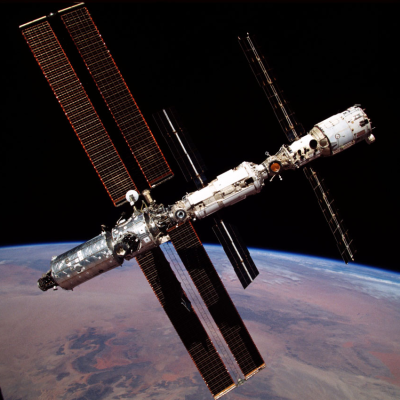
Visiting spacecraft attached to the Russian side of the ISS can transfer propellant into these combined tanks, and they’ve been topped off regularly over the years. In fact, the NASA paper A Review of In-Space Propellant Transfer Capabilities and Challenges for Missions Involving Propellant Resupply, notes this as one of the most significant examples of practical propellant transfer between orbital vehicles, with more than 40,000 kgs of propellants pumped into the ISS as of 2019.
But while the thrusters on Zvezda are still available for use, it turns out there’s an easier way to accelerate the Station; visiting spacecraft can literally push the orbital complex with their own maneuvering thrusters. Of course this is somewhat easier said than done, and not all vehicles have been able to accomplish the feat, but over the decades several craft have taken on the burden of lifting the ISS into a higher orbit.
Earlier this month, a specially modified SpaceX Cargo Dragon became the newest addition to the list of spacecraft that can perform a reboost. The craft will boost the Station several times over the rest of the year, which will provide valuable data for when it comes time to reverse the process and de-orbit the ISS in the future.
Reboosting the Russian Way
By far the easiest way for a visiting spacecraft to reboost the ISS is to dock with the rear of the Zvezda module. This not only places the docked spacecraft at what would be considered the “rear” of the Station given its normal flight orientation, but puts the craft as close as possible to the Station’s own thrusters. This makes it relatively easy to compute the necessary parameters for the thruster burn.
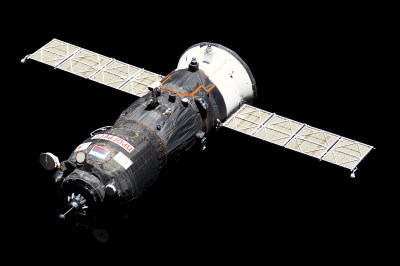
Historically, reboosts from this position have been performed by the Russian Progress spacecraft. Introduced in 1978, Progress is essentially an uncrewed version of the Soyuz spacecraft, and like most of Russia’s space hardware, has received various upgrades and changes over the decades. Progress vehicles are designed specifically for serving long-duration space stations, and were used to bring food, water, propellants, and cargo to the Salyut and Mir stations long before the ISS was even on the drawing board.
Reboosts could also be performed by the Automated Transfer Vehicle (ATV). Built by the European Space Agency (ESA), the ATV was essentially the European counterpart to Progress, and flew similar resupply missions. The ATV had considerably greater cargo capacity, with the ability to bring approximately 7,500 kg of materials to the ISS compared to 2,400 kg for Progress.
Only five ATVs were flown, from 2008 to 2014. There were several proposals to build more ATVs, including modified versions that could potentially even carry crew. None of these versions ever materialized, although it should be noted that the design of the Orion spacecraft’s Service Module is based on the ATV.
American Muscle
Reboosting the ISS from the American side of the Station is possible, but involves a bit more work. For one thing, the entire Station needs to flip over, as the complex’s normal orientation would have the American docking ports facing fowards. Of course, there’s really no such thing as up or down in space, so this maneuver doesn’t impact the astronauts’ work. There are however various experiments and devices aboard the Station that are designed to point down towards Earth, so this reorientation can still be disruptive.
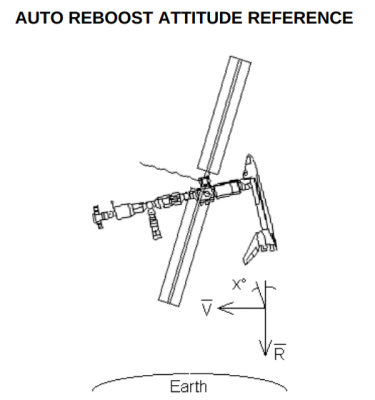 Depending on the spacecraft, simply flipping the Station over might not be sufficient. In the case of the Space Shuttle, which of the American vehicles performed the most reboost maneuvers by far, the entire complex had to be rotated into just the right position so that the thrusters on the spaceplane would be properly aligned with the Stations’ center of mass.
Depending on the spacecraft, simply flipping the Station over might not be sufficient. In the case of the Space Shuttle, which of the American vehicles performed the most reboost maneuvers by far, the entire complex had to be rotated into just the right position so that the thrusters on the spaceplane would be properly aligned with the Stations’ center of mass.
As described in the “AUTO REBOOST” section of the STS-129 Orbit Operations Checklist, the Shuttle’s computer would actually be given control of the maneuvering systems of the ISS so the entire linked structure can be rotated into the correct position. A diagram in the Checklist even shows the approximate angle the vehicle’s should be at for the Shuttle’s maneuvering thrusters to line up properly.
With the retirement of the Space Shuttle in 2011, maintaining the Station’s orbit became the sole domain of the Russians until 2018, when the Cygnus became the first commercial spacecraft to perform a reboost. The cargo spacecraft had a swiveling engine which helped get the direction of thrust aligned, but the Station did still need to rotate to get into the proper position.
After performing a second reboost in 2022, the Cygnus spacecraft was retired. It’s replacement, the upgraded Cygnus XL — is currently scheduled to launch its first mission to the ISS no earlier than September 14th.
Preparing for the Final Push
That brings us to the present day, and the Cargo Dragon. SpaceX had never designed the spacecraft to perform a reboost, and indeed, it would at first seem uniquely unsuited for the task as its “Draco” maneuvering thrusters are actually located on the front and sides of the capsule. When docked, the primary thrusters used for raising and lowering the Dragon’s own orbit are essentially pressed up against the structure of the ISS, and obviously can’t be activated.
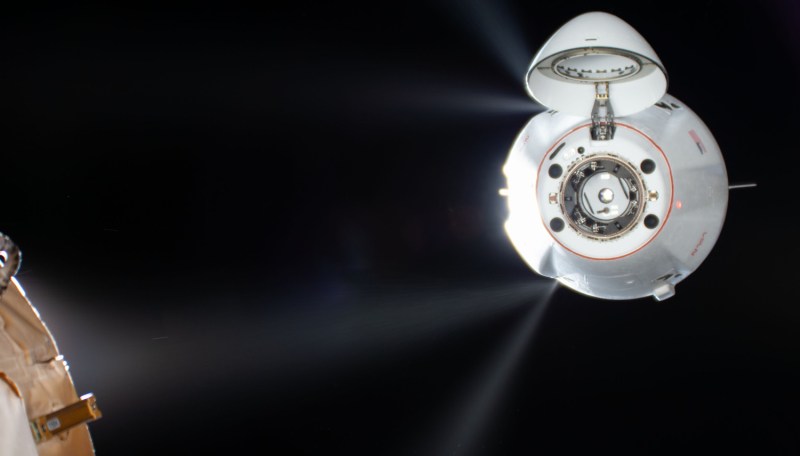
To make reboosting with the Dragon possible, SpaceX added additional propellant tanks and a pair of rear-firing Draco thrusters within the spacecraft’s un-pressurized “trunk” module. This hollow structure is usually empty, but occasionally will hold large or bulky cargo that can’t fit inside the spacecraft itself. It’s also occasionally been used to deliver components destined to be mounted to the outside of the ISS, such as the for the outside of the ISS, such as the International Docking Adapter (IDA) and the roll-out solar panels.
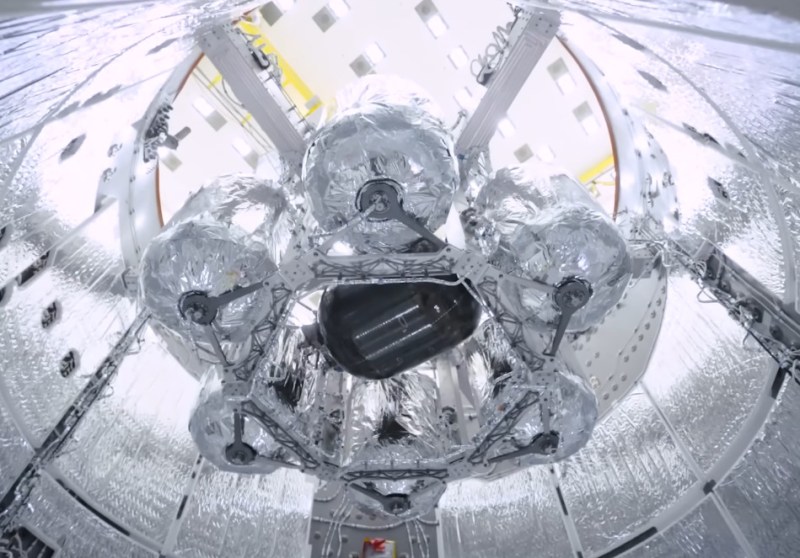
While the ability to have the Dragon raise the orbit of the International Space Station obviously has value to NASA, the implications of this experiment go a bit farther.
SpaceX has already been awarded the contract to develop and operate the “Deorbit Vehicle” which will ultimately be used to slow down the ISS and put it on a targeted reentry trajectory sometime after 2030. Now that the company has demonstrated the ability to add additional thrusters and propellant to a standard Dragon spacecraft via a module installed in the trunk, it’s likely that the Deorbit Vehicle will take a similar form.
So while the development of this new capability is exciting from an operational standpoint, especially given deteriorating relations with Russia, it’s also a reminder that the orbiting laboratory is entering its final days.

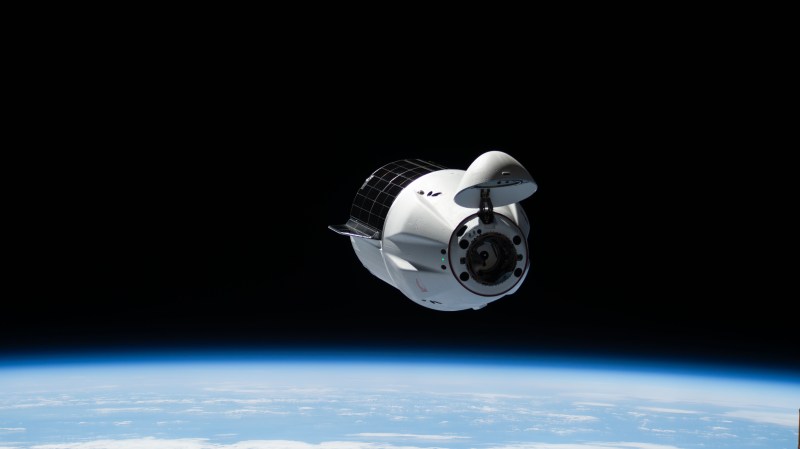














Those tanks don’t look like they take up nearly the volume of the cargo bay. I know it’s all they need and it doesn’t make sense to add more, but I wonder what kind of range the lil guy would have if you packed the entire bay.
Well, as soon as you reached escape velocity you can keep going without having to push (burn fuel) the vehicle. Range then becomes – more or less – infinite. You probably might still want to maneuver ever now and then to avoid hitting stuff (planets, stars, …).
A modern day Space 1999.
Bringing it down is a waste, in my opinion. It’s refined material mass in orbit. How many dollars per kilogram does it take to get from sea level to LEO? No one wants a Kessel event so common sense says something has to be done with it. I don’t know about escape velocity but why not boost it into a Lagrange orbit or crash it on the moon and save the resources for later use?
Yeah, it makes no sense to drop it. But it does make people a bunch of money.
I agree that it should be pushed to the moon. Even just left orbiting there would be more useful than turning it into slag.
Send it 250,000 miles away so we can harvest it sometime in the future? On the Moon? That is the opposite of a good idea. Where was Akismet?
While I’ll agree it’s a bad idea, Akismet is of course not designed to stop bad ideas or negative replies to bad ideas.
Three choices:
planned, deliberate, aimed deorbit, where we try to land it in the vast, mostly empty Pacific
unplanned deorbit by orbital decay — cheapest option is to do nothing, but you might hit something important or kill people.
Spend vastly more money than a planned deorbit to boost into a “graveyard” orbit (significantly more mass to move than a NOAA weather sat. I would assume it would be costly.)
I suppose there might be a fourth option of disassembly in orbit such that the parts wholly burn up on re-entry, but that might not be possible. Besides, you would want the parts to “reentry” rather soon rather than hang around and become even more space junk. NASA Astronauts have already lost a $100,000 tool bag in space, disassembly alone would probably be crazy expensive.
The delta V to get from LEO to L2 is roughly 3.4 km/s. The delta V from the Dragon boost is about 10 m/s.
NASA calculate they’ll need 57m/s to de-orbit the ISS, so I assume the Dragon-deorbit craft will have roughly that much.
“Boosting the International Space Station would require 120-140 m/s delta-V for a 100-year target orbit lifetime and 760 m/s delta-V for a greater than 10,000 year orbit lifetime, in comparison to 57 m/s for a controlled deorbit. ” (https://www.nasa.gov/faqs-the-international-space-station-transition-plan/)
And of course, if you were boosting the orbit, you wouldn’t have to do it all in one go. Multiple craft could be sent up one after the other. Just three Dragon-deorbit craft would be enough to safeguard the ISS for a century.
Station will continue to degrade over time due to micrometeorites and other space junk. If they moved it to lagrange point, there would still need a way to shield it until it can be salvaged for scrap. Taking it to the moon would take far more fuel and more expense than just letting the station fall back to Earth.
If there’s a Kessler syndrome eventually,
it’s likely not caused by ISS but rather some of the thousand SpaceX satellites or some space debris from China.
It’s just kind of sad that the ISS won’t be lifted in grave yard orbit,
were all the other massive junk roams around.
If all involved nations would really support the idea financially and logistically, it could be possible.
If things will continue to evolve the way they do right now,
the ISS will be the last of its kind, like a real world equivalent to B5.
There won’t be another international peace project like this,
every nation rather will be into its own space exploitation from now on.
In big parts thanks to private space programs, too, which are all about profits rather than symbolism and principles of scientific society.
In this hindsight it’s sad that the wrack of the ISS can’t somehow remain in orbit,
as a shining star on night sky to remember future generations
about was international team work used to accomplish.
“it’s likely not caused by ISS but rather some of the thousand SpaceX satellites or some space debris from China.”
This massively depends on the altitude. Starlink, unless they massively raise the altitude, isn’t going to contribute because any satellites that get smashed up would quickly deorbit, due to the drag compared to the mass.
Kessler won’t be caused by SpaceX. Starlink is too low to cause any type of lasting issues, and the satellites will passively deorbit given any issues within a reasonable period of time.
Where it is, drag will being it down eventually (think years, not centuries) so, you would have to boost it, which would be hella expensive.
Then you would leave this junk outside of the magneatosphere, getting bombarded by radiation. Not sure if it will be useful after that.
It is sad, but a controlled decent is the best option. Or just keep using it…
You’d have to accelerate 400 tons by 3.7 km/s to get to geostationary orbit. That’s a lot of fuel, guesstimate over a thousand tons. Lagrange points are a little farther.
Please play some GD KSP.
Escape velocity from what exactly?
Sheriff Rosco?
That game is seriously one of the best ways to get your mind around orbital mechanics and make it into an intuitive thing. It’s not 100% accurate but it’s definitely close enough for most purposes. Solar escape velocity is 42 kilometers per second, maybe they meant once you get over that measly, trivial little barrier you can go wherever… Which is still not true.
There’s a mod that helps with that. Me? My little astronaut is still up there, years later.
That’s a popular misconception, but not how orbital mechanics work I’m afraid. If you point at the sun and thrust a few meters per second, you will not actually reach the sun in a few thousand years. you will simply alter the shape of your orbit slightly. Maybe your apogee will be a bit higher up, but the next time you come back around the Earth you’ll still be in the same trajectory as before. There are in fact fuel requirements (well, to be specific, change in velocity requirements) to get places in space, it’s not a gravity-free zone.
If I’m not mistaken Dragon had tested reboost one time before even without the trunkthrusters just using normal maneuvring thrusters it uses to accelerate docking-port-forward accepting cosine losses in addition to already lower thrust compared to its main thrusters.
For fun I looked up how much fuel a 747 holds- about 180,000 kg which is insane. Alllllll the propellant dumped into ISS since 2019 wouldn’t get you a quarter tank on a 747. Space is hard AF.
“atmospheric drag […] saps enough velocity from the Station”
Uh, no, it doesn’t. Though it may seem paradoxical, atmospheric drag increases the orbital velocity.
By reducing the size (altitude) of the orbit. A sufficiently fast projectile could orbit the Earth at 6 feet above the ground.
There’s a short story about that. It takes place on Mars.
“The Holes Around Mars” by Jerome Bixby:
https://www.gutenberg.org/files/32360/32360-h/32360-h.htm
what? the station is moving considerably faster than the atmosphere that surrounds it? can you explain what you mean?
I’m not sure exactly what you mean. And I have an unused degree in astrophysics.
The station experiences air drag, and air drag reduces velocity.
Maybe you are saying that reducing velocity in orbit will reduce your perigee altitude, which results in a high velocity at that particular future point in your orbit?
But there is no denying that air drag reduces your velocity in the moment while it is happening.
D and Greg: Air drag reduces orbital energy, but not (necessarily) velocity. In a circular orbit (which the ISS is in) and low drag (true in this case), air resistance will tend to reduce orbital altitude slowly. Lower orbital altitude requires higher orbital speed.
So at low air drag, when you’re maintaining a circular orbit and not promptly re-entering, air resistance really does increase orbital velocity. (and also note that an orbit will naturally circularize when air drag is present, because drag at perigee causes altitude loss at apogee, until they’re equal)
It’s not much: a 1 km drop in altitude raises the velocity about 2 m/s, but it’s real.
Ok but then what exactly is changing in terms of physics?
Air should cause friction, which should cause heat, which means lost energy, which means lost speed, which means lower perigee. E=1/2mv^2
Since mass doesn’t change, to reduce energy you can only reduce speed.
ONLY THEN, you’d have a slightly higher speed at perigee than the previous orbit. In theory at least. Because lower perigee means higher drag, which means higher friction which means… Less speed and lower perigee.
Ain’t that right?
In a stable circular orbit, air drag burns off gravitational potential energy, not kinetic energy.
To orbit at lower perigee needs higher velocity.
Paul
AFAIK gravitational potential energy is mgh. Why would friction, something that depends on speed, erode potential energy? Friction always erodes kinetic energy since it depends on kinetic energy.
No kinetic energy, no friction.
It saps from the forward velocity vector thus the dot product of the reduced forward vector with the radial one dependent on the gravity field changes to point more inwards into the orbit, which means it leans more into the field which means this will LATER be stronger and LATER accelerate the object faster.
It seems to me you’re forgetting that there is a time period between the friction taking effect and the speed at perigee becoming faster.
Short impulses of force (momentum change) will act like you describe, where a change in orbital energy will manifest in a change in altitude a half orbit later.
But a small, continuous force will act continuously: The total energy of an object in orbit is the sum of its kinetic and potential energy. Decreasing that total energy slowly will manifest in a slow decrease in orbital radius, which produces an increase in velocity, even though the total energy is decreasing.
In a circular orbit (constant velocity, constant altitude, perigee = apogee), the process is continuous — there isn’t a braking phase and an acceleration phase a half orbit later. The speed increase is continuous while total energy is being reduced.
Ah right, the marvel of integrations 😆
Thanks Paul!
I wonder what the advantage is of using the capsule thrusters instead of thrusters on the iss.
To show it can be done.
Because when it comes time for the Big Push to nudge the ISS into the atmosphere, the on-station thrusters aren’t big enough (it’s said) to give a suitably precise reentry footprint.
The Dragon-derived deorbit vehicle will use something like 25 Draco engines (at 400 N each) to give that shove.
Which is a bit weird, because Zvezda’s thrusters can make 6000 N themselves, 60% of the Draco thrust, so it smells a bit like pork barrels to have to invent a new solution.
Well, it’s also a really good idea to have two independent systems. Imagine you get part way through the burn and Zvezda’s Russian engineering gives out and now the ISS is coming down somewhere random on Earth. 70% odds it’s water, I guess.
But it makes some sense, maybe just from a PR point of view, to have a 2nd set of thruster there that can do the job.
They have a finite lifetime. Better to wear out the visiting vehicle’s thrusters, which have mostly been single-use vehicles anyway, than the station’s own.
Finite indeed: They’ll be ions in the atmosphere or rapidly-cooling slag in the pacific ocean about 40 minutes after that final burn…
That depends on whether the question was about reboost, where wear is the concern, or deorbit, where the on-board tanks aren’t sufficient and they don’t trust the station’s own systems to operate properly late in the process since it will be deeper in the atmosphere than it was designed for.
Swesda is the Russian segment of the ISS and under Russian control, so to say.
And if memory serves, there used to be different opinions between NASA and Roskosmos about the final date for end of mission of ISS.
So perhaps it’s also a little bit about politics, not sure.
But it could be that the Russian side doesn’t really agree with another boost, so it doesn’t like to assist here.
Again, just speculation. There had been so many news in the past 10 years it’s hard to remember everything.
I don’t see why you’d deorbit the ISS unless you’re giving up on space capability completely. My understanding is that anything that can dock with another ship can be repurposed as a ship of theseus to create another station. Ignoring the bulk weight of the station structure, thrusters, power generation, and life support, the sensors and electronics aboard are a GREAT source of spare parts if you run into trouble during construction of a new station, as well as lowering payload mass by reusing as many supplies as possible
Mold spores.
IIRC there’s an age for a human occupied zero G space where the spores become a big problem.
Evolution in action.
If it was me, I’d try evacuating an old part of ISS for a year.
Just to see if the orbit spores really are that tough.
Mir space station had it worse, I think. It was really smelly torwards the end, I believe.
And yet, some brave individuals still had the optimism to attempt to turn it into a space hotel. Love that optimism! ❤️
https://newsimg.bbc.co.uk/1/hi/sci/tech/646921.stm
Grok calculates that based up cost to build and support over it’s existence, every person-HOUR on the ISS cost $146k. It costs very nearly as much per year to support as the total spent thus far on the 13 year old Curiosity Mars rover mission. The cost thus far is almost twice the amount spent on every unmanned probe launched by NASA since 1958. A HUGE waste of money like all “Spam in a can” human spaceflight as Chuck Yeager called the Mercury missions where the hugely expensive to maintain biological payload was mostly there for the ride just like today.
NASA wastes 50% of its funding on that. Book: The End of Astronauts: Why Robots are the Future of Exploration to which I’ll add if it weren’t for corporate lobbies, astronauts in leadership positions, and politicians. And, no, humans aren’t needed to maintain public interest. People quickly bored of the Apollo missions, but the largest web site hits now have been on unmanned missions where people get to see the surfaces of other worlds through robotic eyes.
“based up” > “based upon”
Money isn’t everything. Also, the whole purpose of money is to be spent.
It’s a trade instrument, nothing more and nothing less.
If lots of money is being spent on the people or basic research, it’s good.
The more, the better. Same goes for taxes. They should be spent as much as possible, for the well being of people.
And the people are society as a whole, with all their different opinions.
So individuals here have no say what’s wrong or right or “worth it”.
If they think it’s “waste” they should go into politics or contact a politican and explain why they think so. IMHO.
PS: I’m not from North America.
I also passed the orbital mechanics course. Paul is correct, as unintuitive as it seems. Drag reduces energy, but velocity goes up.
It came to my mind while reading that to compensate that constant drag, it could be usefull to have a (small) constant pull. Would not an ion thruster fit the perfect match in that senario ?
Still think we should splurg for a little bit of gas money to push the thing into a graveyard orbit. Keep it there forever as a testament to our achievements. A memory of better times.